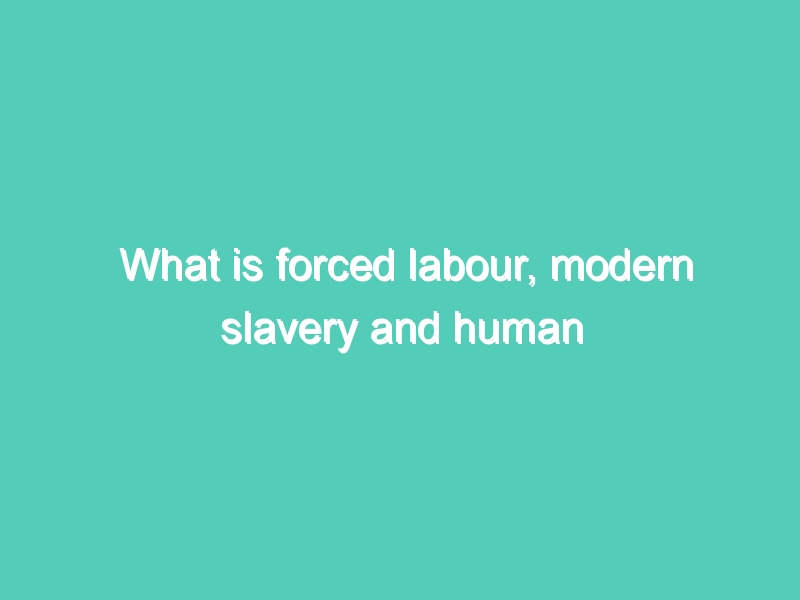What is forced labour?
Forced labour can be understood as work that is performed involuntarily and under the menace of any penalty. It refers to situations in which persons are coerced to work through the use of violence or intimidation, or by more subtle means such as manipulated debt, retention of identity papers or threats of denunciation to immigration authorities.
The Definition of forced labour
According to the ILO Forced Labour Convention, 1930 (No. 29) , forced or compulsory labour is:“all work or service which is exacted from any person under the threat of a penalty and for which the person has not offered himself or herself voluntarily.”
The Forced Labour Protocol (Article 1(3)) explicitly reaffirms this definition.
This definition consists of three elements:
- Work or service refers to all types of work occurring in any activity, industry or sector including in the informal economy.
- Menace of any penalty refers to a wide range of penalties used to compel someone to work.
- Involuntariness: The terms “offered voluntarily” refer to the free and informed consent of a worker to take a job and his or her freedom to leave at any time. This is not the case for example when an employer or recruiter makes false promises so that a worker take a job he or she would not otherwise have accepted.
Exceptions to the “forced labour” definition
Article 2(2) of Convention No. 29 describes five situations, which constitute exceptions to the “forced labour” definition under certain conditions (See General Survey on Forced Labour, ILO Committee of Experts, 2007 ):
- Compulsory military service.
- Normal civic obligations.
- Prison labour (under certain conditions).
- Work in emergency, situations (such as war, calamity or threatened calamity e.g. fire, flood, famine, earthquake).
- Minor communal services (within the community).
Forced labour imposed by state authorities
The Abolition of Forced Labour Convention No. 105 adopted by the ILO in 1957 primarily concerns forced labour imposed by state authorities. It prohibits specifically the use of forced labour:
- as punishment for the expression of political views,
- for the purposes of economic development,
- as a means of labour discipline,
- as a punishment for participation in strikes,
- as a means of racial, religious or other discrimination.
The scope of ILO Instruments on Forced Labour
Both Forced labour Conventions enjoy nearly universal ratification, meaning that almost all countries are legally obliged to respect their provisions and regularly report on them to the ILO’s standards supervisory bodies. Not being subject to forced labour is a fundamental human right: all ILO member States have to respect the principle of the elimination of forced labour regardless of ratification.
In June 2014, governments, employers and workers at the ILO International Labour Conference (ILC) decided to give new impetus to the global fight against forced labour, including trafficking in persons and slavery-like practices.
They voted overwhelmingly to adopt the Protocol of 2014 to the Forced Labour Convention, 1930 and the Forced Labour (Supplementary Measures) Recommendation, 2014 (No. 203) which supplement the Forced Labour Convention, 1930 (No. 29), and complement existing international instruments by providing specific guidance on effective measures to be taken regarding prevention, protection and remedy to eliminate all forms of forced labour.
The reality of forced labour, trafficking and modern slavery
Forced labour can be imposed to adults and children, by State authorities, by private enterprises or by individuals. It is observed in all types of economic activity, such as domestic work, construction, agriculture, manufacturing, sexual exploitation, forced begging, etc. and in every country.
The forced labour definition encompasses:“traditional practices of forced labour, such as vestiges of slavery or slave-like practices, and various forms of debt bondage, as well as new forms of forced labour that have emerged in recent decades, such as human trafficking.”1 also called “modern-slavery” to shed light on working and living conditions contrary to human dignity.
Forced labour is different from sub-standard or exploitative working conditions. Various indicators can be used to ascertain when a situation amounts to forced labour, such as restrictions on workers’ freedom of movement, withholding of wages or identity documents, physical or sexual violence, threats and intimidation or fraudulent debt from which workers cannot escape.
In addition to being a serious violation of fundamental human rights and labour rights, the exaction of forced labour is a criminal offence.
1 ILO, General Survey on the fundamental Conventions concerning rights at work in light of the ILO Declaration on Social Justice for a Fair Globalization , Report of the Committee of Experts on the Application of Conventions and Recommendations, 2012, ILC.101/III/1B, para. 272.



